Poem of Maxim (part of 4)
And both call Maxims.
Again, just pointing the gunner,
With the maximum force beats.
"Well, well, well!" - says the machine gunner
"Well, well, well!" - says the machine gun!
Music: Sigismund Katz. Words: V. Dykhovichny. 1941
The very first instances of the use of machine guns in Africa showed what a powerful combat weapon it is. Naturally, even then, namely at the end of the 19th and the beginning of the 20th centuries, European pacifists began to come out with demands to impose a ban on the use of machine guns, as frankly inhuman weapons. The reason, of course, was not so much their real peace loving, but the fact that Great Britain became the first colonial power, which revealed the advantages of this type of weapon, began to actively use it in clashes with poorly armed indigenous tribes, and well ... as a result, its territory, and earlier not small, began to grow literally as with leaps and bounds.
British soldiers with a machine gun in the Boer War.
One after another, collisions followed, in which the machine gun proved its effectiveness. So, on September 2, 1898, during the battle of Omdurman, the Anglo-Egyptian army of thousands of people in 10 met with the 100-thousandth army of Mahdi, consisting of the irregular Sudanese cavalry. It was a massive machine-gun fire that all its attacks were repulsed with huge losses, while the British units suffered minor losses.
Cecil Rhodes and his "gang" shoots "niggers."
The Russian-Japanese war was the first war in which machine guns were actively used by both warring parties. In the battles of Turenchen and Mukden, the Russian troops inflicted enormous losses on the Japanese machine-gun fire and also played a large role in the defense of Port Arthur. Losses in machine guns were great, but the effect of their use turned out to be so significant that they now began to be bought by the hundreds, despite the price exceeding 3000 rubles for a machine gun. At the same time, high wheel carriages were dismantled, and the machine guns themselves were placed on more convenient and mobile machines.
Russian machine gunners on the hills of Manchuria.
The experience of the war showed that it was necessary to increase the flatness of the shooting, which was also connected with the adoption of a three-line rifle cartridge with a new pointed bullet in 1908. On all machine guns for the new profile of the bullet immediately had to redo the chamber, increase the diameter of the hole in the muzzle sleeve, put a new sight. The machine gun itself was also decided to facilitate and create under it a single universal machine for both infantry and cavalry.
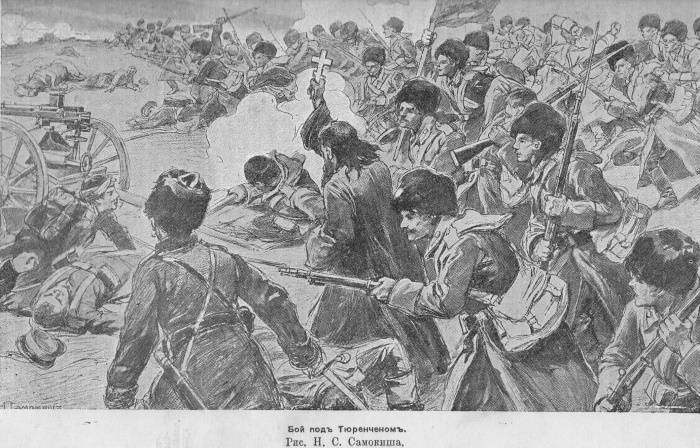
Legendary battle near Turenchen. Fig. artist Samokisha.
In the summer of 1908, Mr. H. Maxim sent a new machine gun to Russia, which made it easier in weight to 18,48 kg. Then in July 1909, a model with a mass of 11,36 kg was received from Vickers. Its specialists were able to replace all parts made of bronze and cast iron with steel ones, they simplified the lock and changed its layout, which significantly reduced the size and weight of the machine gun box, made a new muzzle to it and added a number of other improvements. The new Vickers machine gun had a tripod machine and, together with the cartridge box, could easily be transferred by the calculation of three soldiers.
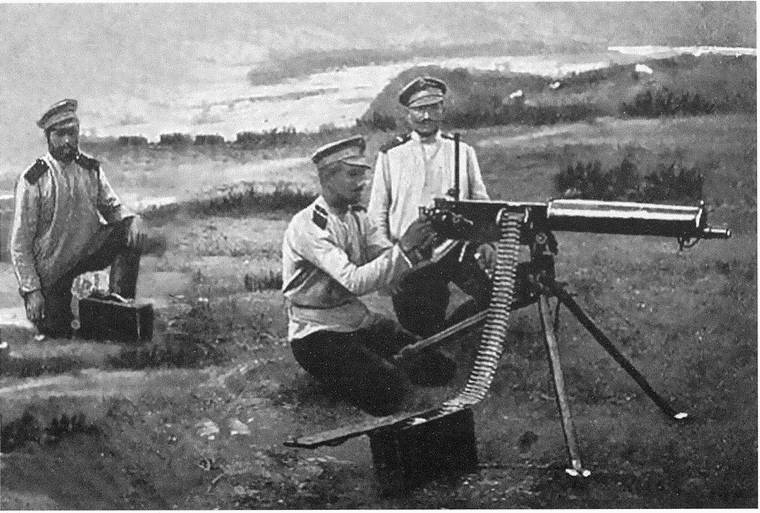
Machine gun and machine gunners Russian-Japanese war.
The Russian military liked the lightweight Vickers, but its tests in the middle of 1910 at the shooting range in the Officer Rifle School ended in failure. The company tried to improve the design, but nevertheless, GAU liked the “lightened” machine gun of the Tula plant more, although it was heavier than the English sample.
And this is our machine guns, but the Japanese trophies!
After testing the Tula machine gun, he entered into service with the Russian imperial army under the name “Maxim machine gun Maxim arr. 1910 G. ”with a wheeled field machine designed by Col. A.A. Sokolova. Indeed, it was seriously improved compared to its prototype, first of all, from the technological point of view, so it is unlikely that the statement that “Russian technicians created, in essence, a new machine gun” can be found in a number of Soviet-era editions. Not new, of course. However, financial relations with Vikkers, Sons and Maxim were reasonably revised after that, agreeing a corresponding reduction in remuneration. Now the position of the Military Council of 4 in March 1910 was: “Under the contract concluded by 9 in March 1904, by the Chief Artillery Directorate with Vickers, Sons and Maxim, pay 1 in January 1910 to the end of 23 in February 1915 in January 60 f. Art. instead of due to this contract 80 f. Art. for every finished machine gun. " At the same time, a new machine for filling machine gun belts with cartridges was designed and adopted.
The famous English "Vikkers" with a reduced box and lightened up utterly. York Castle Museum.
But the machine gun was really a completely new and original development, more than in any country not built. Its development began immediately after the Russian-Japanese war and was based on its experience. Many officers who dealt with machine guns offered their options, among which was the machine of Captain Sokolov, developed back in 1907. It was adopted under the designation “machine arr. 1908, ”but it is usually referred to in the literature as the“ Sokolov machine ”. Well, the serial production of the Maxim and the new machine began in 1911. Meanwhile, Sokolov also developed a machine-gun gig, which was absolutely necessary for transporting machine guns to the front line.
At the same time, machine guns on high-wheel-mounted machines of the early type remained in military schools as training facilities and, for example, were used by the junkers during the battles in Moscow that took place in October-November 1917.
During the First World War, the "Vikkers" fell on airplanes. The second machine gun (it is above the wing) very often became a “Lewis” with no stock and with the radiator removed, since in flight the barrel was well cooled by the flow of incoming air.
It was planned that when the whole program of production of "lightweight" machine guns arr. 1910 will be completed; the old Maxim heavy machine guns (sample 2790 and the British), which were in the 1905 troops, will be reworked, but only 1914 started this business. Under the new ammunition, the old machine guns didn’t have to be redone by the beginning of the war. That's it, so in the fall 1914 from Tula continued to demand "stupid ammunition ... for 100 heavy machine guns." However, the war showed that the level of 1000 machine guns achieved in the country per year was insufficient, although it was seen as the Russian military limit. Machine guns had to be ordered in England and the USA, however, these supplies did not cover the needs of the Russian army!
Upgraded "maxim". The famous wide casting neck, which allowed to fill the casing with snow and ice, and pour water into it directly from the bucket. I wonder why Maxim himself did not think of this simplest solution. Museum of the Penza State University.
During the First World War and then during the Great Patriotic War, "Maxim" was very widespread, primarily because its design was thoroughly tested. What could not be said, for example, about the new Soviet machine gun DS-39. They tried to raise the fire power of “maxim” with the help of paired, and then quadruple installations, used on armored trains, ships and even on the roofs of buildings. For airplanes flying at an altitude of up to 1500 m and at speeds up to 500 km / h, quad machine guns could conduct quite effective and dense fire. The same installations on armored trains and railway platforms were often used to directly support infantry.
The box is much wider compared to the Vickers box.
Whatever it was, but by the end of 1930-ies the Maxim machine gun was already morally obsolete. With a weight of about 65 to without cartridges to carry it across the battlefield was very difficult. In the summer there were difficulties with the supply of water. The cloth tape was difficult to equip, it quickly wore out, often torn and absorbed moisture. At the same time, a single machine gun of the Wehrmacht MG-34 had a weight of 10,5 kg without cartridges, it used a metal tape and it did not need water. Overheated barrel on it could be replaced. It was possible to shoot MG-34 without a machine, which ensured the secrecy of the position of its machine-gun crew. MG-42, which gave 1200 per minute shots, was even more perfect.
Attaching the machine gun to the machine was carried out at two points and was therefore quite tough.
On the other hand, "Maxim" had many positive properties. So, due to the fact that the work of his automation was unstressed, he was stable during the shooting, and had better accuracy than later models. In addition, they were comfortable enough to manage. If the machine gun was properly serviced, then it could have served twice as long as the intended resource, which was already much more than all the newer machine guns.
The sight was rack-mount.
It was precisely because of the problems with reliability and the complexity of production at the beginning of the war that the production of the DS-39 and the Tokarev self-loading rifle had to be abandoned. Simple and tested "three-lane" and equally "brought to mind" "maxim" turned out to be much more popular weapons in this difficult time.
Only in 1943, the SG-43 machine gun with an air-cooled barrel system designed by Pyotr Goryunov went into service, surpassing the “maxim” in many respects. However, the Maxim was produced until the end of the war in the Tula and Izhevsk arms factories, and it was in service until the end of the war. It is known that the last case, when the Soviet army used “maxims” in combat, took place in 1969 during the border incident on Damansky Island.
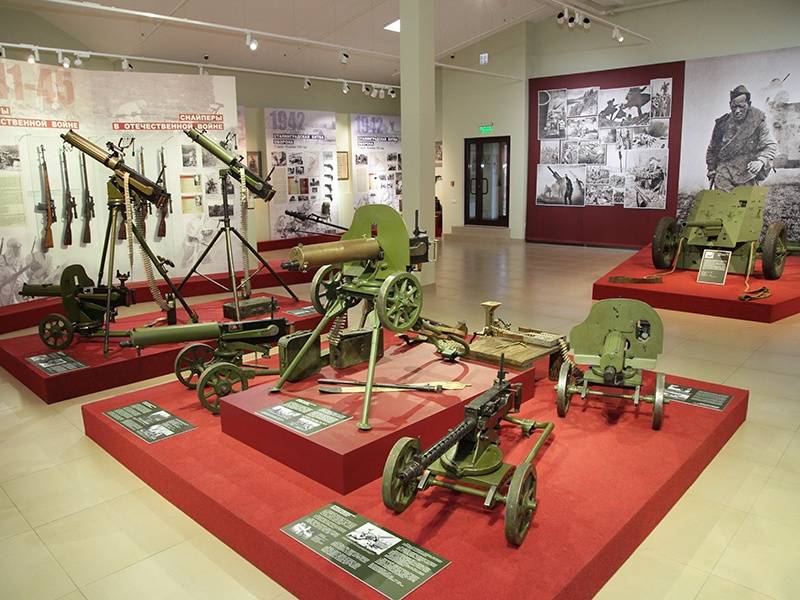
Machine guns "Maxim" in the Museum of the Patriotic Military Stories in Padikovo.
Naturally, such a long, and most importantly significant combat path of the Maxim machine gun in the Russian army led to the fact that he became a hero and an impressive number of books, and no less than the number of movies. The classic example was the film “Chapaev,” in which, in his very first frames, the gallant orderly of Vasily Ivanovich Petka from the cart draws from “maxim” to the white Czechs. And of course, this could well be, in any case, no one was forbidden. That's just one "but." The classic carriage had a suspension on soft springs, and the “maxims” of the times of the Civil War had a weight of more than four pounds. So when firing from the body of the cart, he began to vibrate noticeably, as he demanded a much stronger support than her seat.
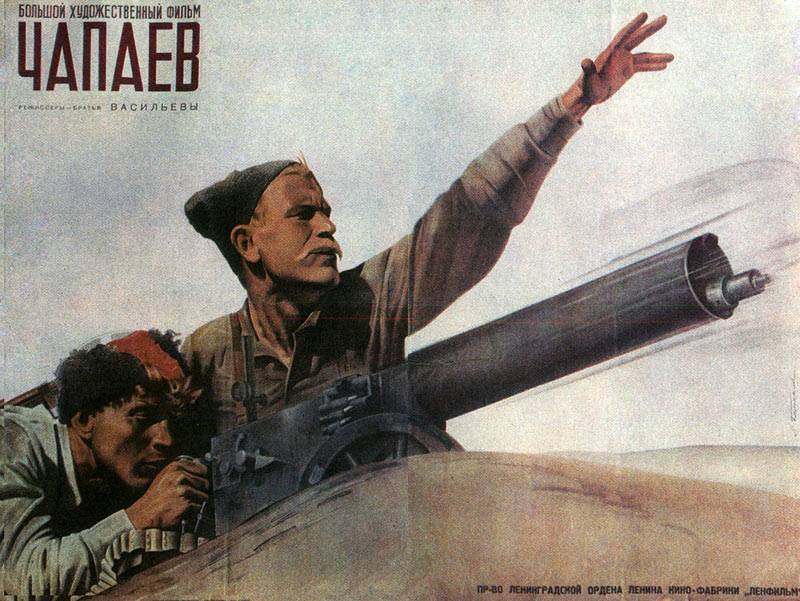
Advertising poster movie "Chapaev".
And, yes - in the Civil War, machine guns on the carts were transported, it is a fact, but, according to the same instruction adopted at the same time, they were put on the ground for firing. Only after the end of the Civil War, so to speak, on the basis of its experience, a tachanka with a more rigid suspension appeared in the Red Army, not so shaky. At the parades, these carts looked very good, but in the battles of the Great Patriotic War they were practically not used. Do not forget that to ensure reliable operation of the "maxim" he needed the second number of machine-gun crew, which was supposed to send the tape at a right angle to the receiver. Without the help of this second number, the machine gun fire could have stopped at any time due to a misalignment of the cartridge.
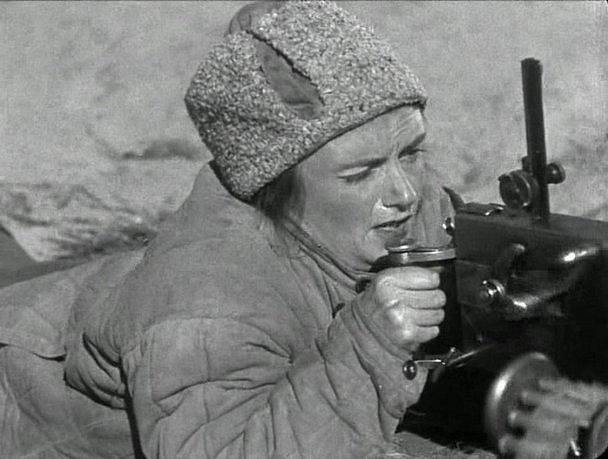
So they, Anka, white animals, so! But without the second number, the tape can be jammed at the most inopportune moment.
And where is this second room could fit on the carriage? However, bad examples, as always, are contagious, and subsequently Petka found many imitators among the heroes of our cinema, who were sniper-struck from the carriages of Maxim, who were racing at full speed, on foot and horsemen!
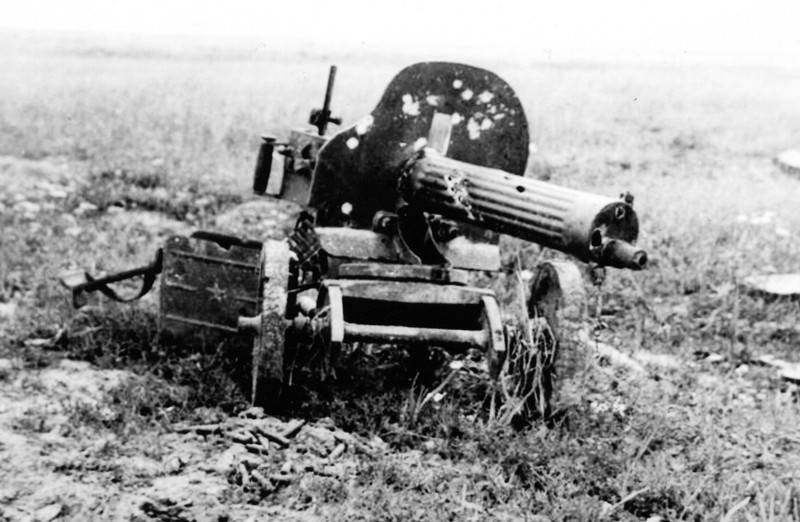
The disadvantage of "Maxim" was his vulnerability ... Bullet holes easily brought him out of action due to the loss of water!
To be continued ...
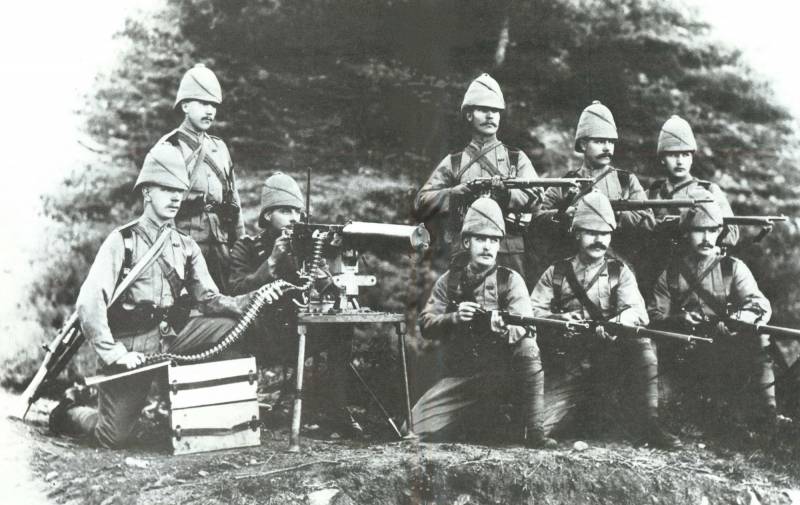
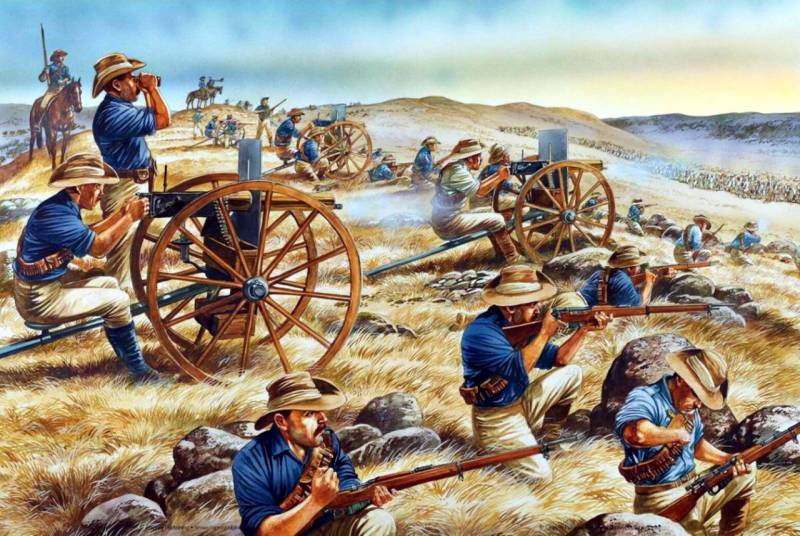
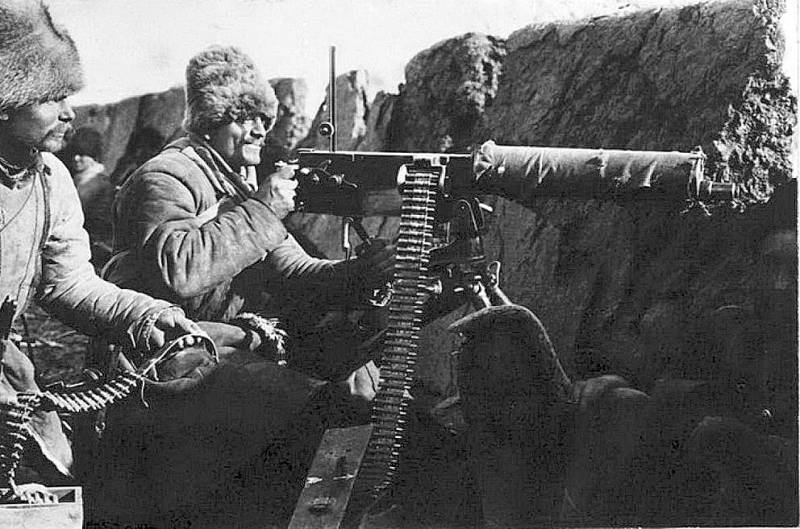
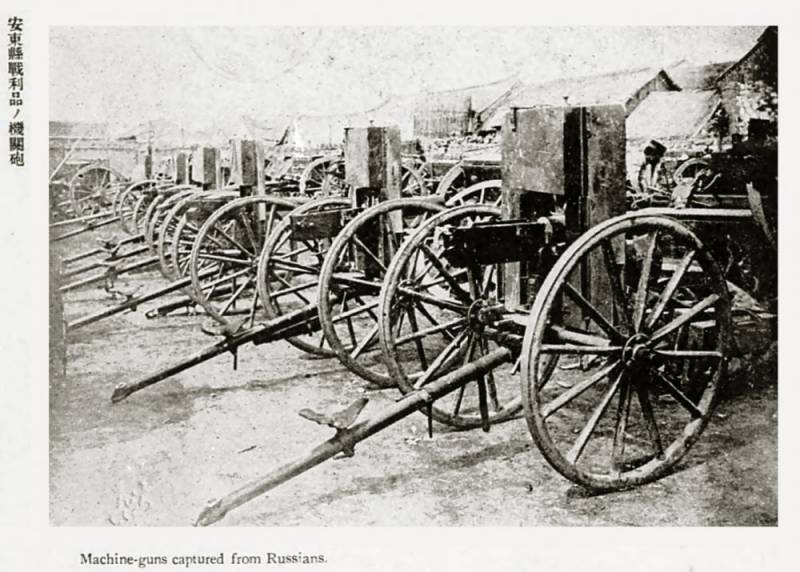
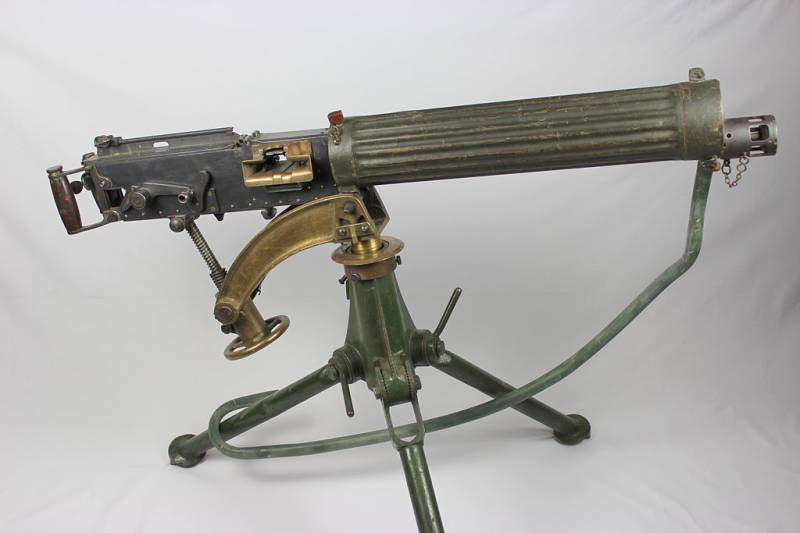
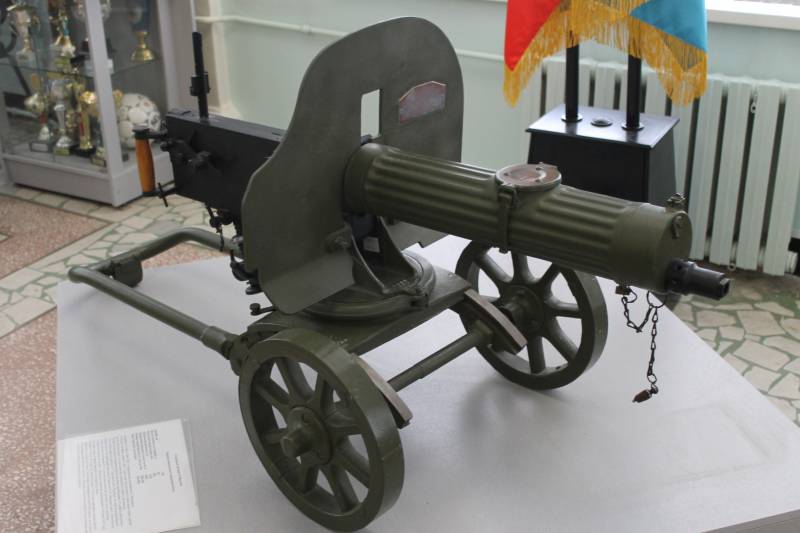
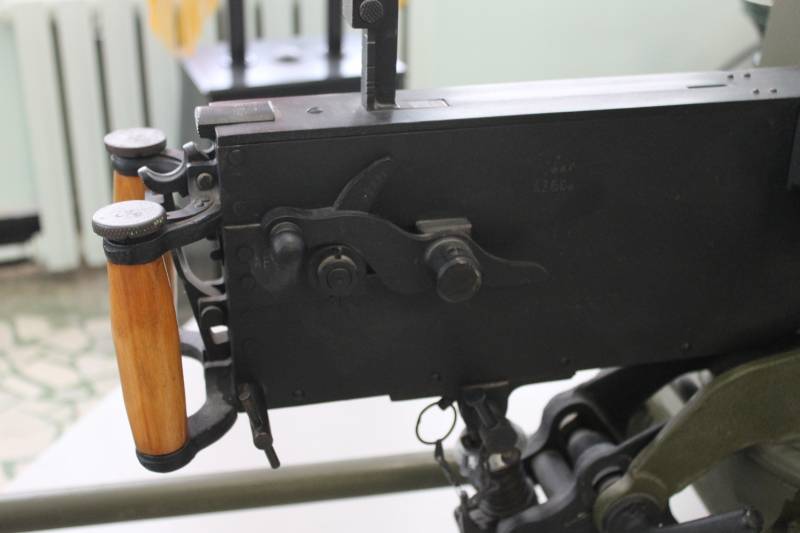
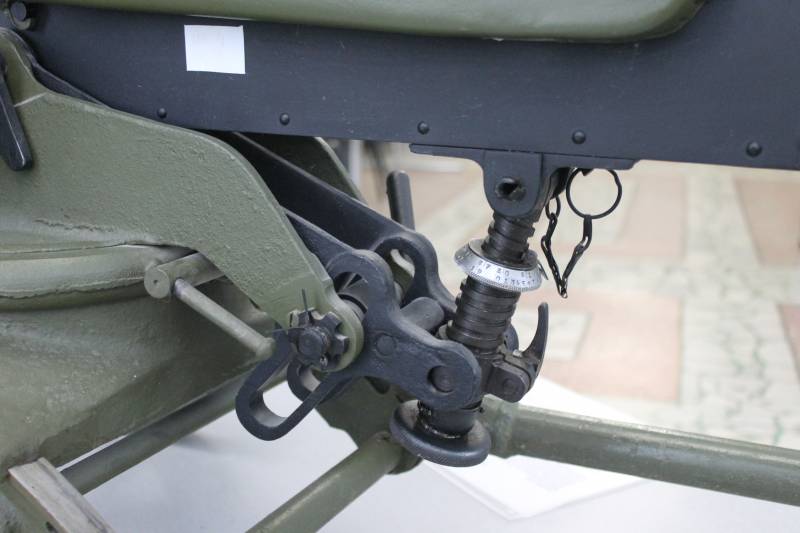
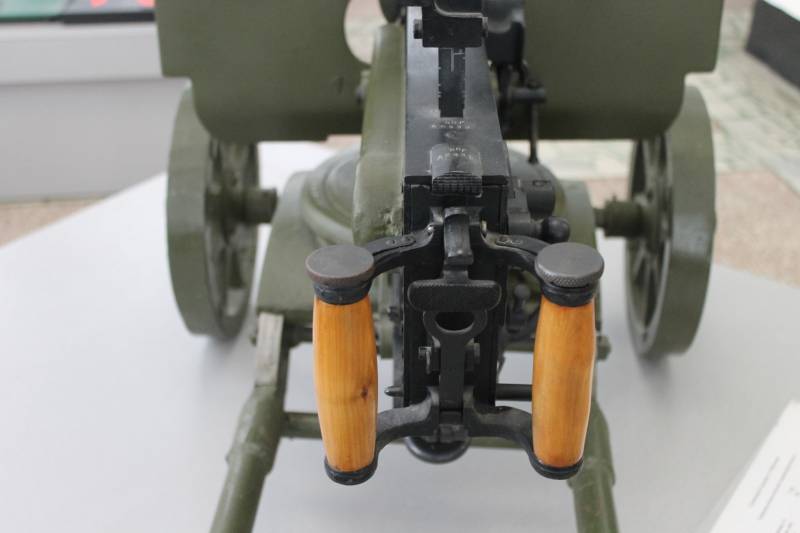
Information